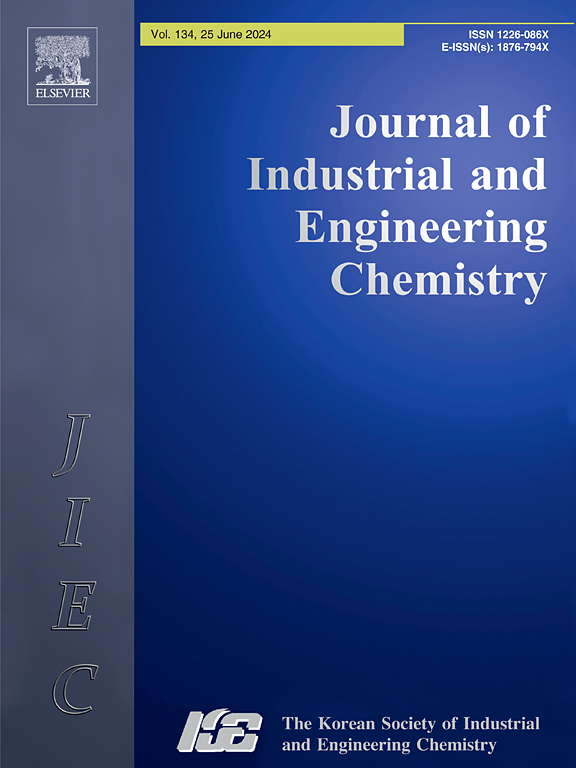反应温度对丁香芽衍生的用于靶向核仁的碳点光学特性的影响
IF 5.9
3区 工程技术
Q1 CHEMISTRY, MULTIDISCIPLINARY
Journal of Industrial and Engineering Chemistry
Pub Date : 2025-01-25
DOI:10.1016/j.jiec.2024.07.006
引用次数: 0
摘要
本研究采用一种简单、环保的水热方法在不同温度下合成丁香芽衍生碳点。在120 ~ 200℃的不同反应温度下,合成了5种不同的ccd样品。利用紫外可见光谱(UV-Vis)和荧光光谱(FL)对不同温度下的ccd的光学特性进行了检测和比较。结果表明,炭化温度对制备的碳点的光学性能有显著影响。对优化后的CCDs进行了细胞相容性和溶血实验,以了解它们在生物环境中的相互作用。并对CDs的自由基清除能力进行了探讨。此外,对优化后的CCDs200进行了体外细胞成像,在不同激光源的激发下,CCDs200表现出强烈的多色发射。有趣的是,CDs能够使富含rna的核仁变亮。核糖核酸酶酶切测试验证了CCDs在核仁中的定位。此外,细胞内稳定性和良好的反染色相容性使其成为核仁成像的有前途的荧光探针。因此,我们已经探索了药用植物果实作为合成CDs的碳前体而不使用任何修饰剂,这可能是多色核仁成像和自由基清除应用的潜在候选物。本文章由计算机程序翻译,如有差异,请以英文原文为准。

Effect of reaction temperatures on optical properties of clove buds derived carbon dots for targeting nucleolus
This work pacts with a simple and environmentally friendly hydrothermal method to synthesize clove buds-derived carbon dots (CCDs) at different temperatures. Five CCDs samples were synthesized at different reaction temperatures ranging from 120 °C to 200 °C, respectively. Using UV–Visible (UV–Vis) and fluorescence spectroscopy (FL), the optical characteristics of CCDs made at various temperatures were examined and compared. The results show that the optical properties of prepared carbon dots (CDs) are significantly influenced by the temperature of carbonization. The cytocompatibility and hemolysis studies of optimized CCDs were performed to understand their interaction in the biological environment. The free radical scavenging capability of CDs was also explored. Further, in vitro cellular imaging of optimized CCDs200 was performed which shows strong and multicolour emission when excited with different laser sources. Interestingly, CDs are capable of brightening up RNA-rich nucleoli. Testing using ribonuclease digestion validates the localization of the CCDs in the nucleolus. Further, intracellular stability and good counterstaining compatibility feature them as a promising fluorescence probe for nucleolus imaging. Therefore, we have explored medicinal plant fruits as a carbon precursor for the synthesis of CDs without using any modifier which can be a potential candidate for multicolour nucleolus imaging and free radical scavenging applications.
求助全文
通过发布文献求助,成功后即可免费获取论文全文。
去求助
来源期刊
CiteScore
10.40
自引率
6.60%
发文量
639
审稿时长
29 days
期刊介绍:
Journal of Industrial and Engineering Chemistry is published monthly in English by the Korean Society of Industrial and Engineering Chemistry. JIEC brings together multidisciplinary interests in one journal and is to disseminate information on all aspects of research and development in industrial and engineering chemistry. Contributions in the form of research articles, short communications, notes and reviews are considered for publication. The editors welcome original contributions that have not been and are not to be published elsewhere. Instruction to authors and a manuscript submissions form are printed at the end of each issue. Bulk reprints of individual articles can be ordered. This publication is partially supported by Korea Research Foundation and the Korean Federation of Science and Technology Societies.

 求助内容:
求助内容: 应助结果提醒方式:
应助结果提醒方式:


